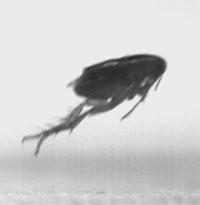We’ve all heard of the age-old Bennet-Clark/Rothschild debate about flea jumping, right? Just to refresh your memory, Henry Bennet-Clark, the researcher who discovered in 1967 that fleas store the elastic potential energy for their jump in a material called resilin, made predictions on the mechanics of flea jumping. Bennet-Clark hypothesized that fleas take to the air by use of the tarsus (toe) in the application of a liftoff force. On the other hand, Miriam Rothschild proposed that fleas use their knees (trochanters) to push off.

Researchers Gregory Sutton and Malcom Burrows, at Cambridge University, recently revisited the debate, applying high-speed imagery, shot at 5000 frames per second, to the problem. The researchers found that, while both the trochanter and tarsus often make contact with the ground, the measured acceleration continues throughout the flea’s jump, even after the trochanter has left the ground, while the tarsus is the only source of liftoff force. Additionally, in 10% of jumps, fleas push off using only the tarsus, and the resulting acceleration is unaffected. Amazingly, that acceleration is around 1,500 m/s2, or 150 g!
Conclusion? Fleas don’t use their knees; they go with their toes. Sutton and Burrows were kind enough to share sample video files of hedgehog flea jumps, which you can download and analyze yourself using the video analysis features ofLogger Pro 3.
To carry out the analysis, we tracked the head and the tail with separate point series and used the new Center of Mass feature of Logger Pro 3.8.4 to track the flea’s motion. We imported an electron micrograph (provided), to scale the video, using the flea’s tibia and the Photo Analysis feature of Logger Pro 3. Finally, we adjusted the frame rate to 5000 fps. Our measured acceleration agreed with that found by Sutton and Burrows.
Download Jumping Flea videos »
Note: Due to the incredibly high frame rate of the video, your points may appear out of sync when you replay them. However, the data used to measure acceleration are still valid.
REFERENCE: Sutton, G. P. and Burrows, M. (2011). Biomechanics of jumping in the flea. J. Exp. Biol. 214, 836-847.
